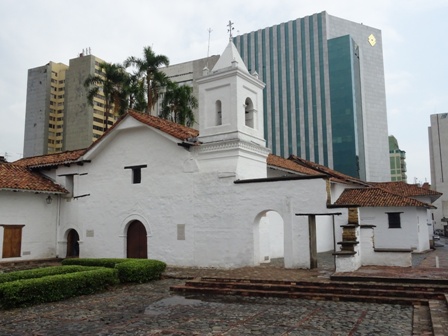
Click the photo above to see a Cali, the Colonial City album. Close the window to return.
Read Previous Episode: Medellin or Next Episode: Popoyan
January 22-25 2016
It was 11:20 AM on a Saturday when we left the adjoining Archaeological Museum of the Merced, which was in itself very interesting, and entered the oldest church in Cali, the Merced with its Colonial Art Museum. We were told the museum was only open until noon and would not be opened again until Monday. We were leaving on Monday. Our only alternative was to visit the church and museum for a short visit.
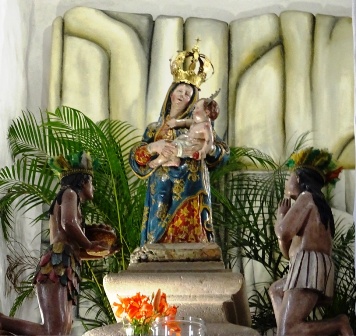 altar tableau highlighting the history of the indigenous people |
It is always interesting and informative to talk to the local people. If we had not had the opportunity to share a seat with a man who regularly travelled between Medellin and Cali, we would not have found out the trick to getting from the airport to Cali the quickest and most economical way. He accompanied us to the shuttle bus to the city bus terminal and made sure the driver knew we wanted a taxi from the bus terminal to our hotel. It was perfect, and less than half the price of an airport taxi. Our home for the next few days was Hotel Boutique San Antonio, conveniently located in an area full of restaurants and just a short walk to all the major Colonial attractions of Cali.
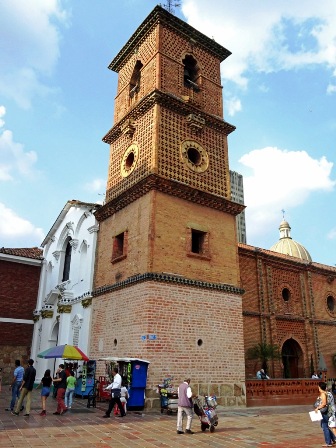 Torre Mudéjar bell tower |
We especially enjoyed the Moorish influence of the architecture of the a 23m high red brick Torre Mudéjar bell tower and the adjacent San Francisco Church, constructed between 1823 -1827, but my favourite was the simple chapel, Capilla de la Immaculata. We wandered around Plaza de Caycedo, dedicated to an 1813 war hero, Joaquim de Caycedo, with its less impressive Cathedral facing across from several Colombian Bank head offices.Cali also had bonus charms for us. We found a number of good restaurants, most in the San Antonio district where we were staying and all of which we recommend to future travelers. Israeli run Zahavi was great for lunch, Zumaia was a treat for dinner and the funky bar/restaurant Maconda, favoured by students had good light meals and if you were lucky, live music. In the city, the gem, La Vegetarian had delicious lunch choices.
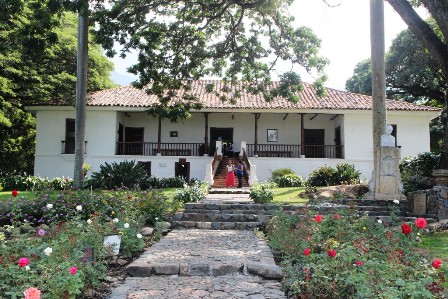 Hacienda El Paraíso |
Click the photo above to see an album of of Haciendas and Sugarcane. Close the window to return.
Conquistador Sebastian de Belalcazar chose a fertile location in the Cauca Valley to found Santiago de Cali, now shortened to Cali, in 1536. Thousands of African slaves were shipped in to work the sugarcane and cotton plantations that flourished in the valley. The Valley remains a major agricultural center but the plantation life with slave labour is long gone. Our hotel had a large collection of paintings by a local artist, depicting Afro-Colombian and Indigenous people, plus one of Hacienda El Paraíso. A tour of part of the valley to visit Hacienda El Paraíso and learn more about the sugar cane plantations was just the thing for a day's outing.
A little over an hour and a mere 36 km north of Cali, our driver, Juan, let us off in front of the rose gardens that welcome you to Hacienda El Paraíso. The hacienda, built between 1816 and 1828, was once owned by the father of author Jorge Isaacs. The house and grounds were acquired by the department of the Cauca Valley and declared a National Monument in 1959. Because the house provided the setting for Isaacs beloved novel, Maria, the house and the grounds have been lovingly preserved as a museum with emphasis on its relationship to the novel. We enjoyed wandering about the grounds and getting a glimpse of the life of 19th C plantation owners.
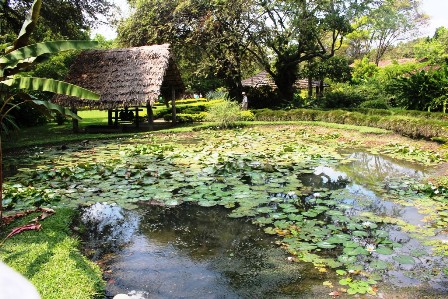 Museo de la Caña de Azúcar (sugarcane museum) |
Our second stop was the Museo de la Caña de Azúcar
(sugarcane museum) at Hacienda Piedechinche. I think Ray and I enjoyed the
grounds and house even more than Hacienda El Paraíso. The property once belonged
to a Spanish family who built the hacienda in 1715 using adobe and cow's blood
to hold it together. Sugar cane is one of the oldest crops in the world. 3,000
years ago it was found in New Guinea and from there, extended into Borneo,
Sumatra and India. The Arabs brought it to Europe and Christopher Colombus
brought it to Esplañola Island, now Haiti and Dominican Republic, in 1493. It
was introduced to Colombia in 1510 by Pedro de Heredia, the founder of
Cartagena, and spread from there.
We started our tour following
a winding, paved walkway through lush grounds, more like a Botanical Garden,
past outdoor displays depicting the history of the sugarcane industry. There
displays ranged from primitive wooden sugar cane presses to modern machinery for
the production of sugar, still an important industry in Colombia.
The hacienda was last on the trail. Decorated in
late 18th C style, the furnished rooms gave a good illustration of how the upper
class Colombians lived. There were photos taken in the 20th C of a family who
were the last residents of the hacienda, but there was no information as to
dates or names. It was a good way to end our visit to Cali and the Cauca Valley.
|
Return to Columbia Intro
Return to Travels
Return to Introduction